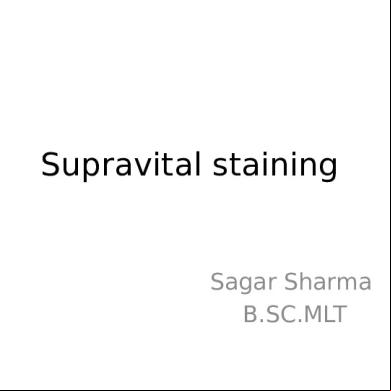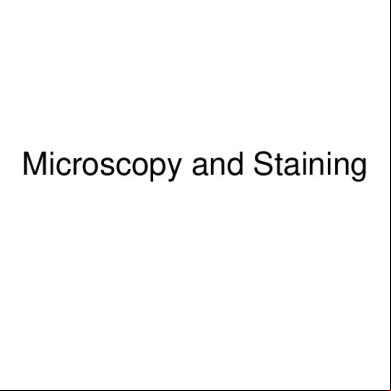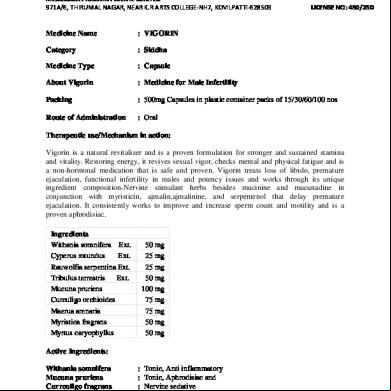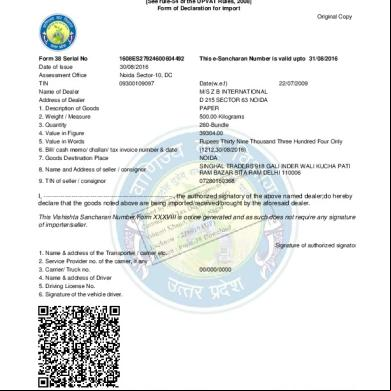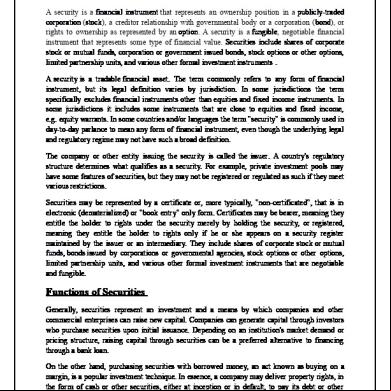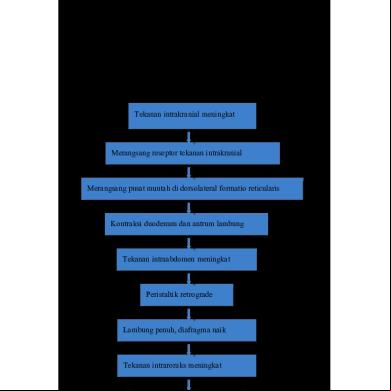Capsule Staining 593z4b
This document was ed by and they confirmed that they have the permission to share it. If you are author or own the copyright of this book, please report to us by using this report form. Report 2z6p3t
Overview 5o1f4z
& View Capsule Staining as PDF for free.
More details 6z3438
- Words: 928
- Pages: 5
CAPSULE STAINING INTRODUCTION Capsule staining is done by using acidic strain and basic strain to detect the presence of capsule. Capsules are:•
Slimy covering which is also called as glycocalyx
or extracellular
polymeric substance •
Usually composed of polysaccharide, polypeptide or both
•
The ability of an organism to produce a capsule is an inherited property of the organism
•
It is often produced only under specific growth conditions
•
Helps bacteria to survive in nature
•
Also helps many pathogenic and normal flora bacteria to initially resist phagocytosis by the host's phagocytic cells
•
In soil and water, capsules help prevent bacteria from being engulfed by protozoans
•
Capsules also help many bacteria to adhere to surfaces and thus resist flushing so not easily stained, this reason negative stain is used
•
It also enables many bacteria to form biofilms o
A biofilm consists layers of bacterial populations adhering to host cells and embedded in a common capsular mass.
PRINCIPLE •
Capsules protect bacteria from the phagocytic action of leukocytes and allow pathogens to invade the body
•
Bacterial capsules are non-ionic, so neither acidic nor basic stains will adhere to their surfaces so an acidic stain is used
•
A stain which stains the background against which the uncolored capsule can be seen.
•
Procedure is called the Gin's Method where india ink is used to color the background and crystal violet to stain the bacterial cell "body"
•
this structure helps the bacterial cell to attach to surfaces and avoid being phagocyted
•
Common example would be Klebsiella pneumoniae
METHODS Use a loop to mix a drop of water, a drop of india ink and a small amount of Klebsiella pneumoniae together at the end of a slide
Use another slide to spread the smear like a blood smear. Allow the smear to air dry.
Flood the smear with crystal violet, 1 minute. Wash with water, blot, dry, observe. RESULTS + = Positive (clear "halos" around cells when viewed under oil immersion - = Negative (no clear "halos" around cells when viewed under oil immersion
ENDOSPORE STAINING INTRODUCTION The endospore stain is a differential stain used to visualize bacterial endospores. Endospores are formed by a few genera of bacteria, such as Bacillus . By forming spores, bacteria can survive in hostile conditions. Spores are resistant to heat, dessication,
chemicals,
and
radiation.
Bacteria
can
form
endospores
in
approximately 6 to 8 hours after being exposed to adverse conditions. The normallygrowing cell that forms the endospore is called a vegetative cell. Spores are metabolically inactive and dehydrated. They can remain viable for thousands of years. When spores are exposed to favorable conditions, they can germinate into a vegetative cell within 90 minutes. Endospores can form within different areas of the vegetative cell. They can be central, subterminal, or terminal. Central endospores are located within the middle of the vegetative cell. Terminal endospores are located at the end of the vegetative cell. Subterminal endospores are located between the middle and the end of the cell. Endospores can also be larger or smaller in diameter than the vegetative cell. Those that are larger in diameter will produce an area of "swelling" in the vegetative cell. These endospore characteristics are consistent within the spore-forming species and can be used to identify the organism.
Because of their tough protein coats made of keratin, spores are highly resistant to normal staining procedures. The primary stain in the endospore stain procedure, malachite green, is driven into the cells with heat. Since malachite green is watersoluble and does not adhere well to the cell, and since the vegetative cells have been disrupted by heat, the malachite green rinses easily from the vegetative cells, allowing them to readily take up the counterstain. PRINCIPLE Endospores do not stain easily but, once stained,they strongly resist decolorization. This property is the basis of the Schaeffer-Fulton or Wirtz-Conklin method of staining endospores. Spores have a durable outer coating that is composed of the protein keratin. This keratin coat resists staining so in order to stain a spore the primary stain, malchite green, must be heated to drive the stain into the spores. Vegatative cells are then decolorized with water and 0.5% safranin is used to counterstain. Thus endospores are stained green, while vegetative cells are stained red. METHOD With a wax pencil, the names of the respective bacteria placed on the edge of four clean glass slide
Aseptically one species of bacterium is transferred with an inoculating loop to each of the respective slides, air dry (or use a slide warmer), and heat-fix.
the slide to be stained is placed on a hot plate or boiling water bath equipped with a staining loop or rack. the smear is covered with paper toweling that has been cut the same size as the microscope slide
the paper is soaked with the malachite green staining solution. Gently heat on the hot plate (just until the stain steams) for 5 to 6 minutes after the malachite green solution begins to steam. Replace the malachite green solution as it evaporates so that the paper remains saturated during heating.
Remove the paper using forceps, allow the slide to cool, and rinse the slide with water for 30 seconds.
Counter stain with safranin 60 -90seconds Rinse the slide with water for 30 seconds.
Blot dry with bibulous paper and examine under oil immersion. A coverslip is not necessary. The spores, both endospores and free spores, stain green; vegetative cells stain red.
RESULTS The stain Shows a bacterium capable of endospore production. A. Vegetative Cell B. Endospore
Slimy covering which is also called as glycocalyx
or extracellular
polymeric substance •
Usually composed of polysaccharide, polypeptide or both
•
The ability of an organism to produce a capsule is an inherited property of the organism
•
It is often produced only under specific growth conditions
•
Helps bacteria to survive in nature
•
Also helps many pathogenic and normal flora bacteria to initially resist phagocytosis by the host's phagocytic cells
•
In soil and water, capsules help prevent bacteria from being engulfed by protozoans
•
Capsules also help many bacteria to adhere to surfaces and thus resist flushing so not easily stained, this reason negative stain is used
•
It also enables many bacteria to form biofilms o
A biofilm consists layers of bacterial populations adhering to host cells and embedded in a common capsular mass.
PRINCIPLE •
Capsules protect bacteria from the phagocytic action of leukocytes and allow pathogens to invade the body
•
Bacterial capsules are non-ionic, so neither acidic nor basic stains will adhere to their surfaces so an acidic stain is used
•
A stain which stains the background against which the uncolored capsule can be seen.
•
Procedure is called the Gin's Method where india ink is used to color the background and crystal violet to stain the bacterial cell "body"
•
this structure helps the bacterial cell to attach to surfaces and avoid being phagocyted
•
Common example would be Klebsiella pneumoniae
METHODS Use a loop to mix a drop of water, a drop of india ink and a small amount of Klebsiella pneumoniae together at the end of a slide
Use another slide to spread the smear like a blood smear. Allow the smear to air dry.
Flood the smear with crystal violet, 1 minute. Wash with water, blot, dry, observe. RESULTS + = Positive (clear "halos" around cells when viewed under oil immersion - = Negative (no clear "halos" around cells when viewed under oil immersion
ENDOSPORE STAINING INTRODUCTION The endospore stain is a differential stain used to visualize bacterial endospores. Endospores are formed by a few genera of bacteria, such as Bacillus . By forming spores, bacteria can survive in hostile conditions. Spores are resistant to heat, dessication,
chemicals,
and
radiation.
Bacteria
can
form
endospores
in
approximately 6 to 8 hours after being exposed to adverse conditions. The normallygrowing cell that forms the endospore is called a vegetative cell. Spores are metabolically inactive and dehydrated. They can remain viable for thousands of years. When spores are exposed to favorable conditions, they can germinate into a vegetative cell within 90 minutes. Endospores can form within different areas of the vegetative cell. They can be central, subterminal, or terminal. Central endospores are located within the middle of the vegetative cell. Terminal endospores are located at the end of the vegetative cell. Subterminal endospores are located between the middle and the end of the cell. Endospores can also be larger or smaller in diameter than the vegetative cell. Those that are larger in diameter will produce an area of "swelling" in the vegetative cell. These endospore characteristics are consistent within the spore-forming species and can be used to identify the organism.
Because of their tough protein coats made of keratin, spores are highly resistant to normal staining procedures. The primary stain in the endospore stain procedure, malachite green, is driven into the cells with heat. Since malachite green is watersoluble and does not adhere well to the cell, and since the vegetative cells have been disrupted by heat, the malachite green rinses easily from the vegetative cells, allowing them to readily take up the counterstain. PRINCIPLE Endospores do not stain easily but, once stained,they strongly resist decolorization. This property is the basis of the Schaeffer-Fulton or Wirtz-Conklin method of staining endospores. Spores have a durable outer coating that is composed of the protein keratin. This keratin coat resists staining so in order to stain a spore the primary stain, malchite green, must be heated to drive the stain into the spores. Vegatative cells are then decolorized with water and 0.5% safranin is used to counterstain. Thus endospores are stained green, while vegetative cells are stained red. METHOD With a wax pencil, the names of the respective bacteria placed on the edge of four clean glass slide
Aseptically one species of bacterium is transferred with an inoculating loop to each of the respective slides, air dry (or use a slide warmer), and heat-fix.
the slide to be stained is placed on a hot plate or boiling water bath equipped with a staining loop or rack. the smear is covered with paper toweling that has been cut the same size as the microscope slide
the paper is soaked with the malachite green staining solution. Gently heat on the hot plate (just until the stain steams) for 5 to 6 minutes after the malachite green solution begins to steam. Replace the malachite green solution as it evaporates so that the paper remains saturated during heating.
Remove the paper using forceps, allow the slide to cool, and rinse the slide with water for 30 seconds.
Counter stain with safranin 60 -90seconds Rinse the slide with water for 30 seconds.
Blot dry with bibulous paper and examine under oil immersion. A coverslip is not necessary. The spores, both endospores and free spores, stain green; vegetative cells stain red.
RESULTS The stain Shows a bacterium capable of endospore production. A. Vegetative Cell B. Endospore



